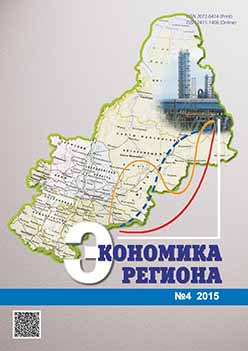Оптимизация управления финансовыми потоками на основе оценки региональных мультипликативных эффектов
Optimization of Financial Flow Management Based on Estimates of Regional Multiplicative Effects
Author(s): Denis Aleksandrovich Tatarkin, Elena Nikolayevna Sidorova, Aleksandr Valeryevich TrynovSubject(s): Economy, Geography, Regional studies
Published by: Институт экономики Уральского отделения Российской академии наук
Keywords: multiplier; matrix of financial flows (MFF); multiplicative effect; consolidated budget balance; endogenous and exogenous factors of economic growth;
Summary/Abstract: The article deals with questions of increasing the management efficiency of the regional financial resources. As the main hypothesis, the idea of the optimization of the management of the regional financial flows based on the multiplicative economic effect is proved. This measure will allow to evaluate more efficiently the impact of the regional socio-economic policy. The article presents a multifactor model of the management of the regional financial flows on the regional level — the matrix of financial flows, based on the principles of the general economic equilibrium theory, the balance method of «input-output» and the methodology of national accounts. The paper introduces a methodology for the integration of the regional consolidated budget balance in a matrix of financial flows. Matrix multipliers of the consolidated budget balance are calculated for some regions of the Russian Federation allowing to model the economic multiplicative effects resulting from impact of different types of exogenous factors on the economic development of the regions, such as to predict the impact of fiscal redistribution on the GRP and income, to assess the impact of foreign investment on economic growth, to explore the effectiveness of the federal tax policy at the regional level. The article shows that the multiplier effect depends on several factors, including the foreign trade relations of the region, its dependence on imports, the share of value added in gross output, as well as the household savings. Various levels of government can use the author’s approach during development of strategies for socio-economic development, in assessing the extent and direction of the influence of exogenous factors on the economy of the territory, as well as in analyzing the investment initiatives from the private sector applying for state financial support for projects. In the conclusion, the ways of improving the management of financial flows on the basis of maximizing the multiplicative economic effects in the short and medium term for regions with a different level of budgetary provision are proposed.
Journal: Экономика региона
- Issue Year: 11/2015
- Issue No: 4
- Page Range: 323-335
- Page Count: 13
- Language: Russian

